

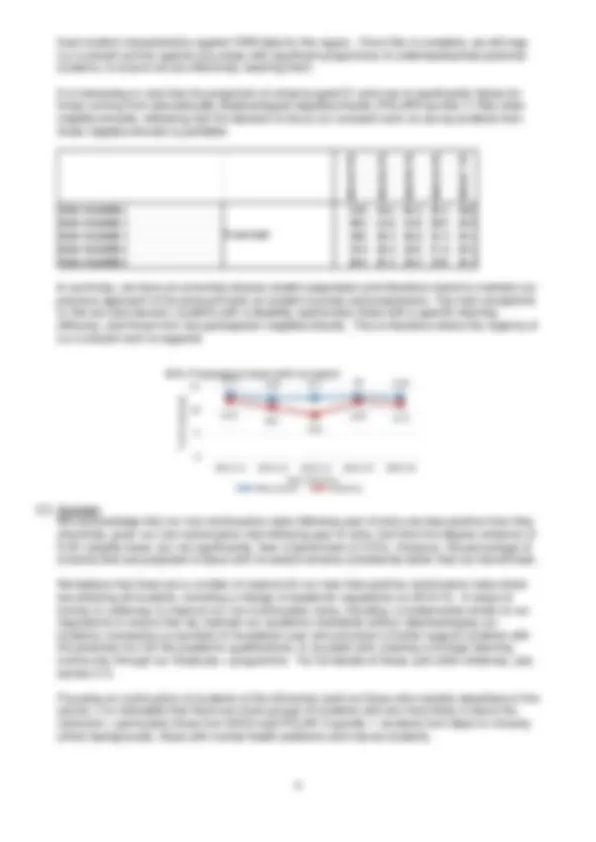
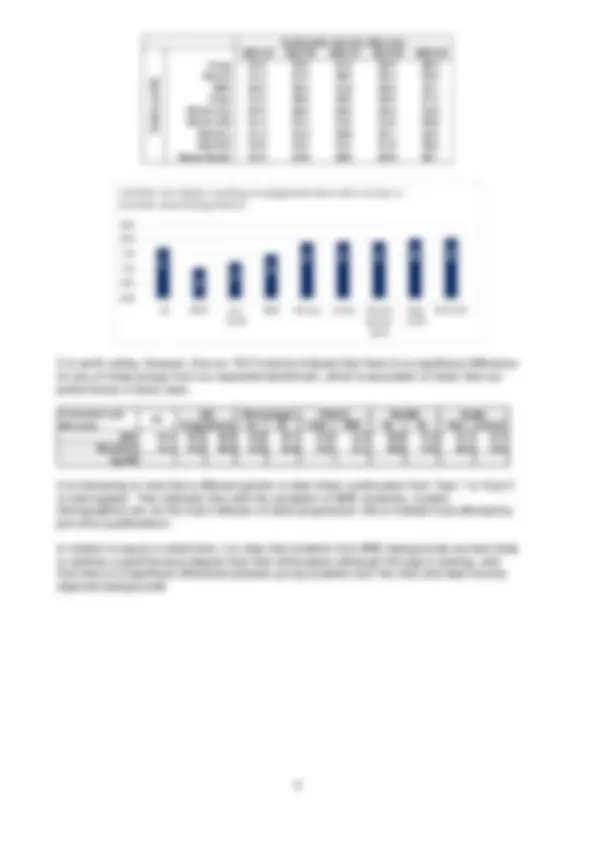
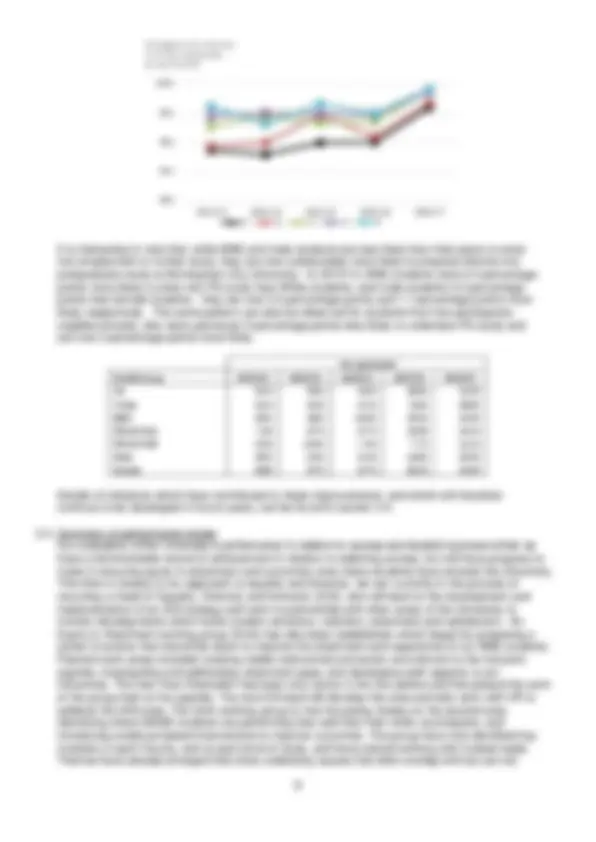

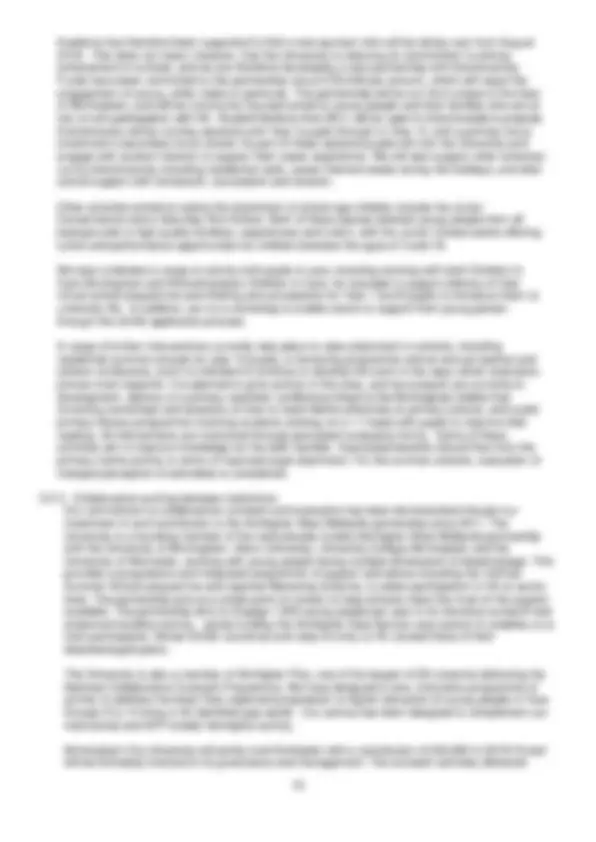





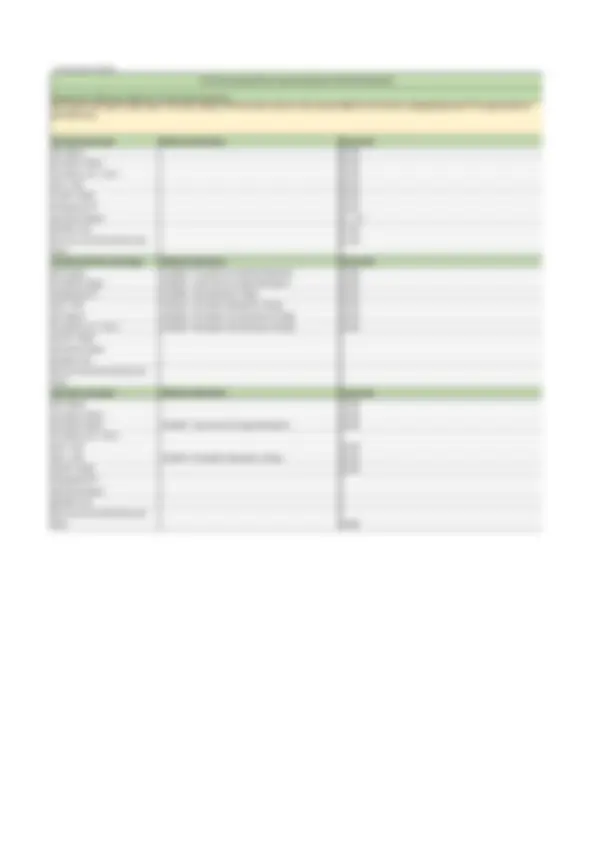




Study with the several resources on Docsity

Earn points by helping other students or get them with a premium plan


Prepare for your exams
Study with the several resources on Docsity

Earn points to download
Earn points by helping other students or get them with a premium plan
Community
Ask the community for help and clear up your study doubts
Discover the best universities in your country according to Docsity users
Free resources
Download our free guides on studying techniques, anxiety management strategies, and thesis advice from Docsity tutors
ACCESS AND PARTICIPATION PLAN 2019-20. 1. Introduction. Birmingham City University recognises that the decision to enter higher education is a life-changing.
Typology: Study notes
1 / 22

This page cannot be seen from the preview
Don't miss anything!















Birmingham City University recognises that the decision to enter higher education is a life-changing one. However, for some of our prospective and current students, the decision is a harder one to make because of their personal circumstances. The UK Government, working with Higher Education Institutions, aims to minimise or remove the barriers to under-represented or disadvantaged students attending university and succeeding once there. At Birmingham City University, we aim to widen participation and support success in higher education, in particular for students who:
Birmingham City University performs reasonably well both in absolute terms and by comparison to sector benchmarks in indicators of widening access. Examination of the most recent HESA performance indicators reveals that:
Our HESA data shows that our full-time undergraduate population is extremely diverse, with over a third of entrants coming from the most income deprived neighbourhoods (IDACI Q1) in England and half of all entrants from a variety of ethnic minority backgrounds. It is worth noting that main cycle acceptances between 2012 and 2017 from BME applicants had increased by approx. 50% compared to only a 25% increase in BME applications and for White ethnic background applicants, a 13% increase in accepted applicants compared to a 10% increase in applications. We are therefore continuing to see increased demand from applicants of all backgrounds and are matching this demand with increased acceptances in the main UCAS cycle.
Looking at the breakdown of entrants from specific backgrounds, it becomes clearer that there are some groups who are underrepresented but others where we recruit significantly over the sector average and the median for Post-92 HEIs.
The percentage of entrants declaring a disability is below both the sector average and the median of Post-1992 HEIs, but has been growing steadily over recent years. In contrast, the proportion of students declaring a specific learning difficulty has decreased. As a result, we are providing focused support for students with specific learning difficulties to successfully make the transition into higher education – see section 3.3 for more details. We also have reason to believe that the main issue is not one of access per se, but actually of students under-reporting (potentially due to their cultural and/or socio-economic backgrounds). For example, it is noticeable that the percentage of students who declare a disability increases as the educational advantage of their home neighbourhood (measured through POLAR3) increases and also as the income deprivation of their neighbourhood decreases. Trend data indicates that we have been successful in increasing the number of disabled students from POLAR3 quintile 1, as this percentage has grown far more quickly than those from other quintiles. Percentages of disabled students from all IDACI quintiles apart from quintile 5 have increased over the past five years, in spite of the changes to DSA eligibility, suggesting that we have managed to satisfactorily offset any impact that this may have had on students from low income backgrounds through the work outlined in section 3.3.
As a result, we are establishing an assessment centre which will (among other things) support new entrants to identify the level of support they need even if they have not previously received a diagnosis. More information can be found in section 3.3.
2012/13 (%) 2013/14 (%) 2014/15 (%) 2015/16 (%) 2016/17 (%) Polar 3 Quintile 1 4.4 6.5 7.7 8.5 9. Polar 3 Quintile 2 5.0 6.8 7.0 6.2 7. Polar 3 Quintile 3 6.5 7.2 7.3 7.8 8. Polar 3 Quintile 4 8.7 9.6 8.4 9.9 12. Polar 3 Quintile 5 10.0 10.3 12.7 11.9 12.
% DISABLED
2012/13 (%) 2013/14 (%) 2014/15 (%) 2015/16 (%) 2016/17 (%) IDACI Quintile 1 5.0 5.2 6.1 5.5 7. IDACI Quintile 2 4.3 6.6 6.7 8.6 8. IDACI Quintile 3 7.4 10.2 8.1 7.9 10. IDACI Quintile 4 7.6 8.1 10.8 10.2 14. IDACI Quintile 5 12.0 11.4 13.5 14.6 12.
% DISABLED
Under-represented group Source 2012/13 (%) 2013/14 (%) 2014/15 (%) 2015/16 (%) 2016/17 (%) Sector average (%) Post 1992 HEI median Ethnic backgrounds HESA Entrant Population 45.1 47.4 45.1 47.1 48.7 26.6 16. Care Leaver (OFFA countable) HESA Entrant Population n/a 0.1 0.3 0.0 0.0 n/a n/a Declared a disability HESA Entrant Population 8.8 10.0 10.3 10.0 11.8 13.5 14. Declaring a mental health problem HESA Disabled Population 9.6 10.6 14.5 19.4 23.3 21.9 21. Declaring a specific learnng difficulty HESA Disabled Population 59.2 58.4 52.0 46.1 41.6 42.8 42. IMD - IDACI Quintile 1 HESA Entrant Population 27.0 28.5 30.2 32.1 33.9 n/a n/a Mature (21 years or older) HESA Entrant Population 36.5 30.0 31.5 30.0 29.9 22.8 26.
local student characteristics against ONS data for the region. Once this is complete, we will map our outreach activity against any areas with significant proportions of underrepresented potential students, to ensure we are effectively reaching them.
It is interesting to note that the proportion of entrants aged 21 and over is significantly higher for those coming from educationally disadvantaged neighbourhoods (POLAR3 quintile 1) than other neighbourhoods, indicating that the decision to focus our outreach work on young students from these neighbourhoods is justifiable.
In summary, we have an extremely diverse student population and therefore intend to maintain our previous approach of focusing primarily on student success and progression. The main exceptions to this are care-leavers, students with a disability (particularly those with a specific learning difficulty), and those from low participation neighbourhoods. This is therefore where the majority of our outreach work is targeted.
2.2. Success We acknowledge that our non-continuation rates following year of entry are less positive than they should be, given our non-continuation rate following year of entry (full-time first degree entrants) of 9.9% (slightly lower, but not significantly, than a benchmark of 9.3%). However, the percentage of entrants who are projected to leave with no award remains consistently better than our benchmark.
We believe that there are a number of reasons for our less than positive continuation rates which are affecting all students, including a change of academic regulations on 2015/16. A range of activity is underway to improve our non-continuation rates, including: a fundamental review of our regulations to ensure that we maintain our academic standards without disadvantaging our students; increasing our portfolio of foundation year zero provision to better support students with the potential, but not the academic qualifications, to succeed and; creating a stronger learning community through our Graduate + programme. For full details of these, and other initiatives, see section 3.3.
Focusing on continuation of students at the University (and not those who transfer elsewhere in the sector), it is noticeable that there are some groups of students who are more likely to leave the institution – particularly those from IDACI and POLAR 3 quintile 1, students from black or minority ethnic backgrounds, those with mental health problems and mature students.
2012/13 (%) 2013/14 (%) 2014/15 (%) 2015/16 (%) 2016/17 (%) Polar 3 Quintile 1 43.8 36.1 40.2 35.1 36. Polar 3 Quintile 2 38.9 32.0 33.0 30.5 29. Polar 3 Quintile 3 36.9 30.3 30.6 31.3 29. Polar 3 Quintile 4 33.3 26.2 26.5 27.6 29. Polar 3 Quintile 5 29.4 25.3 26.3 23.9 25.
% MATURE
13.4 (^) 12.6 12.7 13 12.
12.1 (^) 10.
11.8 (^) 11.
0
5
10
15
2011/12 2012/13 2013/14 2014/15 2015/
% of entrants
Year of entry
BCU: Projected to leave with no award
Benchmark Indicator
Continuation into Year after entry
Student profile
2011/12 2012/13 2013/14 2014/15 2015/ Young 91.5 91.5 91.4 88.3 86. Mature 91.2 87.8 88.5 86.4 85. BME 90.3 90.4 91.0 86.6 84. White 92.2 90.8 90.5 88.9 87. POLAR 3 Q1 89.3 88.8 89.9 86.9 84. POLAR 3 Q5 91.2 92.2 91.9 91.0 90. IDACI Q1 91.4 91.0 90.0 85.1 83. IDACI Q5 92.9 92.3 92.1 91.0 89. Mental Health 92.3 92.0 89.6 89.0 85.
It is worth noting, however, that our TEF3 metrics indicate that there is no significant difference for any of these groups from our expected benchmark, which is equivalent or lower than our performance in every case.
It is interesting to note that a different pattern is seen when continuation from Year 1 to Year 2 is interrogated. This indicates that (with the exception of BME students), student demographics are not the main indicator of clean progression: this is instead most affected by pre-entry qualifications.
In relation to equity in attainment, it is clear that students from BME backgrounds are less likely to achieve a good honours degree than their white peers (although this gap is closing), and that there is a significant difference between young students from the most and least income deprived backgrounds.
Young Mature Yes No White BME Yes No Male Female BCU 92.1 93.3 89.5 92.6 93.7 91.8 92.4 90.6 92.2 91.1 92. Benchmark 91.4 92.5 89.0 92.0 93.0 91.6 91.1 90.6 91.5 89.4 92. Sig Diff
Continuation yearafter entry ALL AGE Disadvantaged Ethnicity Disabled Gender
77%
70%^ 72%
75%
79%^ 79%^ 79%^ 80%^ 80%
60%
65%
70%
75%
80%
85%
All BTEC Low Tariff
BME Mature White Mental Health/ SpLD
High Tariff
IDACI Q
Full-time First Degree: Continue on programme from Year 1 to Year 2: Entrants commencing 2016/
It is noticeable that some groups are not as successful as others at obtaining higher skilled employment or further study opportunities, especially Asian and male students. It is encouraging that whilst we historically experienced a large performance gap between students from the most and least income deprived backgrounds, this gap has now closed significantly.
Year graduated 2012/13 2013/14 2014/15 2015/16 2016/ All 69.2% 69.0% 70.7% 71.0% 76.9% White 75.1% 74.6% 76.5% 76.7% 80.9% Black 69.4% 67.2% 70.2% 73.3% 78.3% Asian 57.2% 57.8% 61.0% 61.9% 70.3% Other 69.1% 70.6% 63.8% 74.1% 75.1% Male 68.1% 65.6% 69.0% 68.2% 75.1% Female 71.0% 72.0% 72.3% 74.3% 79.3% POLAR 3 Q1 72.2% 68.9% 73.5% 76.4% 79.3% POLAR 3 Q5 73.3% 71.9% 72.7% 72.4% 76.8% IDACI Q1 67.2% 67.2% 67.3% 69.2% 77.2% IDACI Q5 77.0% 70.0% 79.4% 77.0% 81.3%
The performance gap for Asian students also holds for entry into all types of employment and further study, although the gap between male students of different ethnicities has narrowed over recent years – White male graduates still outperform those from Asian backgrounds, the gap has narrowed from 7% to 5%.
Mirroring the case for higher skilled employment, the gap between students from different areas of income deprivation entering into any form of employment or further study has also narrowed considerably over the past five years, from 6% to 3%.
Young Mature Yes No White BME Yes No Male Female BCU 70.0 64.4 83.0 62.5 65.4 74.9 63.1 71.8 69.7 66.0 72. Benchmark 70.4 66 80.5 64 67.2 74 65.4 70.8 70.3 69 71. Sig Diff -ve -ve
Higher skilled Disabled Gender employment or ALL^
AGE Disadvantaged Ethnicity
80%
85%
90%
95%
100%
2012/13 2013/14 2014/15 2015/16 2016/
Birmingham City University: UK FT UG employability - Male Graduates
White Black Asian Other Ethnicity
It is interesting to note that, while BME and male students are less likely than their peers to enter into employment or further study, they are now substantially more likely to progress directly into postgraduate study at Birmingham City University. In 2012/13, BME students were 0.4 percentage points more likely to enter into PG study than White students, and male students 0.5 percentage points than female students - they are now 3.5 percentage points and 1.7 percentage points more likely respectively. The same pattern can also be observed for students from low participation neighbourhoods, who were previously 2 percentage points less likely to undertake PG study and are now 3 percentage points more likely.
Year graduated Profile Group 2012/13 2013/14 2014/15 2015/16 2016/ All 8.1% 9.5% 8.5% 10.9% 12.3% White 8.1% 9.3% 6.1% 8.6% 10.8% BME 8.5% 9.8% 11.8% 13.5% 14.3% POLAR 3 Q1 7.2% 8.7% 9.7% 13.0% 14.1% POLAR 3 Q5 9.2% 11.5% 7.4% 7.7% 11.1% Male 8.5% 9.3% 8.2% 12.6% 13.5% Female 8.0% 9.7% 8.7% 10.1% 11.8%
Details of initiatives which have contributed to these improvements, and which will therefore continue to be developed in future years, can be found in section 3.4.
2.4. Summary of performance review Our evaluation of the University’s performance in relation to access and student success is that we have a demonstrable record of achievement in relation to widening access, but still have progress to make in ensuring equity in attainment and outcomes once these students have entered the University. This links in closely to our approach to equality and diversity: we are currently in the process of recruiting a Head of Equality, Diversity and Inclusion (EDI), who will lead on the development and implementation of an EDI strategy and work in partnership with other areas of the University to monitor developments which foster student attraction, retention, attainment and satisfaction. An Equity in Attainment working group (EinA) has also been established, which began by proposing a series of actions that should be taken to improve the attainment and experience of our BME students. Planned work areas included creating visible institutional and senior commitment to the inclusion agenda, investigating and addressing attainment gaps, and developing staff capacity to act inclusively. The new Vice-Chancellor has been very active in the first sphere and has placed the work of the group high on his agenda. The new EDI lead will develop this area and also work with HR to address the third area. The EinA working group is now focussing closely on the second area: identifying where BAME students are performing less well than their white counterparts, and introducing evidence-based interventions to improve outcomes. The group have now identified key modules in each Faculty, and at each level of study, and have started working with module leads. Themes have already emerged that show underlying causes that often overlap with but are not
80%
85%
90%
95%
100%
2012/13 2013/14 2014/15 2015/16 2016/
Birmingham City University: UK FT UG employability - By IDACI Quintile
1 2 3 4 5
Academy has therefore been supported to find a new sponsor who will be taking over from August
Other activities aimed at raising the attainment of school age children include the Junior Conservatoire and a Saturday Arts School. Both of these expose talented young people from all backgrounds to high quality facilities, experiences and tuition, with the Junior Conservatoire offering tuition and performance opportunities for children between the ages of 3 and 18.
We also undertake a range of activity with pupils in care, including working with both Children in Care Birmingham and Wolverhampton Children in Care, for example to support delivery of their virtual school programme and offering annual sessions for Year 7 and 8 pupils to introduce them to university life. In addition, we run a workshop to enable carers to support their young person through the UCAS application process.
A range of further interventions currently take place to raise attainment in schools, including residential summer schools for year 10 pupils, a mentoring programme and an annual teacher and advisor conference, and it is intended to continue to develop this work in the ways which evaluation proves most impactful. It is planned to grow activity in this area, and two projects are currently in development: delivery of a primary teachers’ conference linked to the Birmingham Maths Hub (involving workshops and sessions on how to teach Maths effectively at primary school), and a pilot primary literacy programme involving students working on a 1:1 basis with pupils to improve their reading. All interventions are monitored through participant evaluation forms. Some of these activities aim to improve knowledge for the staff member. Associated benefits should flow from the primary maths activity in terms of improved pupil attainment. For the summer schools, evaluation of changed perception of attendees is considered.
3.2.2. Collaborative working between institutions Our commitment to collaborative outreach and evaluation has been demonstrated though our investment in and contribution to the Aimhigher West Midlands partnership since 2011. The University is a founding member of the institutionally funded Aimhigher West Midlands partnership with the University of Birmingham, Aston University, University College Birmingham and the University of Worcester, working with young people facing multiple dimensions of disadvantage. This provides a progressive and integrated programme of support and advice including the UniFest Summer School programme and regional Mentoring Scheme, to widen participation in HE at sector level. The partnership acts as a single point of contact to help schools make the most of the support available. The partnership aims to engage 1,000 young people per year in its intensive outreach and attainment building activity. Jointly-funding the Aimhigher Data Service (see section 5) enables us to track participants, whose GCSE outcomes and rates of entry to HE exceed those of their disadvantaged peers.
The University is also a member of Aimhigher Plus, one of the largest of 29 consortia delivering the National Collaborative Outreach Programme. We have designed a new, innovative programme of activity to address the lower than expected progression to higher education of young people in Year Groups 9 to 13 living in 25 identified gap wards. Our activity has been designed to complement our institutional and APP funded Aimhigher activity.
Birmingham City University will jointly fund Aimhigher with a contribution of £35,000 in 2018/19 and will be intimately involved in its governance and management. The outreach activities delivered
through the partnership will complement our own extensive programme of widening access and fair access measures outlined elsewhere in this Plan.
3.3. Student Success The University continues to undertake a wide range of activity to support student success. This involves, among other activities: An evolving approach to work on induction, transition and first year experience that is informed by previous participation in the HEA’s national ‘What Works’ Student Retention and Success initiative. In 2017, this saw the University host the European First Year Experience Conference which provided an opportunity for staff to further engage in refreshing approaches and learn from practices from 18 countries from across the world. Continued development of the Level Up online pre-transition initiative, delivered from the point of student confirmation of place into their first few months at university. This continues to be adopted by schools and programmes across the University and sees incremental changes each year as the initiative develops. Appointment of Graduate Student Success Advisors (GSSA) in all Faculties. These roles, initially piloted in one Faculty from 2013, are undertaken on a full-time basis by recent graduates and serve to provide a wide range of informal support and bridging between students and staff. The role and numbers of graduates appointed has been rising with some Schools now recruiting their own. This is a real area of success with the Arts, Design and Media Faculty appointing 9 GSSAs in the present year as their impact on student retention became clear. The Graduate+ initiative, which seeks to align student personal development, employability and belonging. Through initial participation in activities such as Welcome Week, students make connections with staff and students (personal tutors, Library induction) across the university that receive recognition through the framework. Once students become connected, Graduate+ starts to explore their sense of purpose and how we can help them engage with the resources to achieve that. In the first two years of operation over 9000 students registered for this extra- curricular award. Early evaluative data suggests that a significantly higher proportion of BME students and students with a disability access the programme than might be expected given the institutional demographic. The next phase of Graduate+ is to engage with Birmingham’s local communities. Over 70% of our students are commuters and live across Birmingham. Through engagement with organisations and activities in their local environments we plan to better support those students and show the relevance of their university experience to those communities. An integrated approach to Welcome Week delivering stronger induction to the wider University and alignment with Graduate+ initiative; Successful initiatives in Student Mentoring (39 student engagement projects funded in 2017-
The University was successful in being awarded by HEFCE call (circular 04/2015) to pilot and evaluate measures of learning gain. This partnership project is being led by Birmingham City University with partners at Coventry, Liverpool John Moores and Staffordshire. This work includes measures around student improvement in knowledge, skills, work readiness and personal development. It will be aligned to measures offered through the UK Engagement Survey. Additionally, the University has been successful in attracting HEFCE Catalyst B funding as part of a regional university/FE colleges partnership (DRIVER). This initiative looks at a West Midlands approach to the BME attainment issue and how universities and colleges might learn from each other and share data to address BME attainment gap issues.
The University has increased its support for students to cope with the ‘hidden costs’ of Higher Education, by providing pre-entry information on the types of additional costs that students may
eligible to join HARS are identified at the end of Year 1 based on academic performance and ‘distance travelled’ metrics. Following an invitation to one of the bi-annual HARS Launch events those eligible can then apply for a place. HARS students complete an on-line profiling questionnaire which informs a follow-up interview with a Careers coach to establish which aspects of the Scheme they are most interested in from across the four available tracks of advanced academic skills; leadership development; community engagement; and international mobility. Funding for the Scheme is provided through the Faculty’s existing Student Learning Experience budget. By the end of 2016- 17, 225 students had registered with the Scheme out of a total of 537 eligible, based on the metrics used. This second year of operation saw the first full cohort with both second and final year students engaging with the HARS offer. By the end of January 2018 HARS reached a probable steady-state with around 800 students per annum deemed eligible, subject to successful application, out of a Faculty population of 10,000. The first HARS graduates were conferred in summer 2017 and the Team already have these Alumni supporting ongoing HARS work in the Faculty even as they embark on their own professional careers.
Additionally in the Faculty of HELS, there is a SEDA accredited Advanced Personal Tuition Forum (APTF) which provides personal tutors in HELS with up-to-date knowledge of the services and support in the University that they can draw down in order to support their students. Personal tuition can be transformational, enhancing the quality of students’ experiences and boosting outcomes. It improves individuals’ capacity to plan and take responsibility for their learning and to understand how they learn. The APTF is designed to improve student success and retention rates through enhanced training for personal tuition and the use of a bespoke dispositions and behaviours questionnaire for students piloted in HELS during 2016-17. The questionnaire provides students with valuable insights into behaviours that are associated with academic success (e.g. resilience and mindfulness) and others that are associated with academic underperformance or failure (e.g. procrastination). The APTF introduces personal tutors to knowledge and understanding drawn from research and the literature on self-efficacy and factors that can undermine student success. In addition the Forum provides participants with opportunities to hone and reflect upon key skills development as personal tutors through the introduction of tool kits and structured evaluations of professional practice.
HELS has been trialling a bespoke dispositions and behaviours questionnaire for students (designed in partnership with colleagues in the Faculty of Business, Law and Social Sciences (BLSS)) piloted during 2016-17 alongside its Advanced Personal Tuition Forum for staff. The questionnaire provides students with valuable insights into behaviours that are associated with academic success and others that are associated with academic underperformance or failure. We plan to use the questionnaire and the Forum to increase the efficacy of personal tuition in HELS and BLSS as part of a joint, cross-Faculty initiative. The preliminary work already completed has shown that the personality and behavioural constructs used in this initiative predict higher performance, increased well-being and mental health of students, as well as higher NSS scores and an enhanced student experience. We have also learned that BAME students are not underperforming (as indicated by the metrics outlined in section 3) when they score highly in the constructs featured in this research (e.g. resiliency, mindfulness and self- compassion). In addition, we have run randomized control trials to investigate whether utilizing interventions to enhance those personality and behavioural constructs would enhance student performance, well-being, and the student experience. Our findings to date have been positive, and we are currently exploring commuter student experience and the relationship to our constructs. The possibility of securing additional funding is being investigated, to enable a two-year development cycle at the end of which a student mindfulness ‘app’ and associated staff training packages would be self- sustaining and available for use and adoption across the University as a whole.
The Faculties also take different approaches to embedding sustained contact with employers throughout the student lifecycle (due primarily to the diverse employment markets targeted by graduates from each Faculty). For example, in 2015/16 a new high-level vision statement was created by the Faculty of Computing, Engineering and the Built Environment (CEBE), stating that "By 2020, we will transform CEBE graduate employment through our globally recognised research, innovative practice and outstanding educational experiences”. In turn, this vision informed the design of the Faculty’s Curriculum Philosophy, now developed into an underpinning strategy for Learning, Teaching and Assessment. It positions the curriculum as an opportunity to embed fundamental employment skills by the use of a practice-facing, experiential approach to learning, in particular by emphasising the
creation of artefacts in a project-driven learning environment. The following specific projects are generating great experiences and demonstrating good practice for wider adoption in the future: The cross-programme Innovation Fest is now in its 5th year, with each occurrence a significant expansion on the experience of the year before. In 2018, some 400 students from the School of Computing and Digital Technology worked together in collaborative teams to design and implement solutions to real-world problems; the ideas they have created are then displayed as part of a major exhibition at the end of May, in which representatives from major employer partners form the judging panel selecting the best designs with the most potential for future development. Final year students also participate and mentor their more junior colleagues. The Faculty has a number of other initiatives designed to embed employer partners into key curriculum activities, including: Industry-mentored projects: final year Computing students have co-developed their major project with a ‘problem sponsor’ drawn from industry, providing direct input into shaping their outcomes, and offering employers an extended look at some of our graduating students. Module Industrial Mentors: Our Digital Media students are able to access advice and guidance from industry mentors attached to specific modules; often alumni of the courses themselves, this offers the chance to create a direct channel of communication into key industry figures, and enable students to develop confidence and contacts in their chosen field. Student Competitions : for example, students in Built Environment programmes develop a live project during Welcome Week, and pitch their ideas direct to an industrial representative before their formal taught programme has even started. An Industrial Advisory Board meets regularly in each school, to discuss areas of common interest in the development of faculty programmes, the alignment of graduates to industry needs, areas for future collaboration, etc.
The School of Nursing takes a different approach, for example through its Nursing Partnership Employability Group, which has the following objectives: To understand, review and act upon recruitment and selection information in partnership with the stakeholders. To ensure that students are well prepared for the job application and interview process. To ensure understanding of workforce needs through strong partnerships with key stakeholders, including employers, students, alumni, careers and academic staff. To develop an understanding of the transitional journey into qualified practice of our students from stakeholder perspectives. To develop strategies to enable a smooth transition. This group meets three times a year, and involves academic staff and representatives from all local and wider regional NHS trust partners (who are the main employers of graduates from the School).
Finally, the University has recently completed a review of all of its undergraduate courses, with new and revised courses being introduced from September 2017 and rolled out incrementally until 2020/21 (by which time all undergraduates should be studying on a revised programme). The underpinning academic strategy means that courses will be more flexible and more accessible for all students (including disabled, mature and part-time learners). As with many other cross-institutional initiatives, the precise manner of implementation has been left to the discretion of individual areas, rather than centrally directed – however, all programme review proposals had to explicitly identify how they would achieve greater flexibility and inclusiveness. One example of this is BA (Hons) English. This programme has a number of specific pathways but there is now the opportunity for students to transfer to the broad BA (Hons) English course which offers more flexibility in the choice of optional modules. The review also includes the introduction of a number of foundation year zero courses, to ensure that students who have the potential to succeed but who may not have the necessary academic qualifications have the opportunity to enter higher education with more targeted support. The University also intends to expand its range of higher apprenticeships and other forms of work-based learning in order to facilitate access for all students, including those who are known to be less likely to enter more traditional forms of higher education, such as those from white socio- economically disadvantaged backgrounds. It is currently too early to identify the impact of this programme review, as the first year has yet to be finished. However, progress made in terms of changes to student cohort demographics, retention and clean progression from Year 1 to Year 2 will be monitored at programme and School level through the annual programme healthchecks (outlined in section 4), with specific focus being given to changes in key success metrics for the groups
3.5. Financial Support As in previous years, the University will continue to support students suffering hardship to at least the level previously funded by the Access to Learning Fund (ALF). Moreover, the University may choose to augment this sum and provide additional funding, dependent upon the specific nature of the applications received for hardship funding. The University continues to receive demand for hardship support from its students and the figure indicated is incremental to this ALF figure, and may rise as required to meet those needs. In recent years, we have had to commit funding far in excess of the amount committed to in our Access Agreements (and expect to exceed the amount in this Access and Participation Plan).
In order to calculate hardship support for students, BCU uses the NASMA-set Composite Living Cost figure to set thresholds which accounts for an element of inflation and means that hardship funds provided reflect accurately the cost of living.
In 2016/17, the majority of recipients were full-time, home undergraduate students, with a high representation of final year students – indicating that resources are predominantly being used to support those nearing the end of their course.
Level of study of students receiving funding UG UG PG PG Total 1 2 3 4 5 S total 1 2 3 total
£000 awards 97.8 135.6 307.7 1.9 0.9 12.8 556.7 33.6 8.1 2.3 44.2 600.
The outcomes for students in receipt of hardship funding were marginally more positive than those for the general population, with 93.7% achieving a positive outcome.
Retention and progression rates of students receiving funding Complete / Proceed
Exit / Withdraw with award
Fail / withdraw / cannot proceed
Not known
£000 awards 466.7 16.4 11.8 37.
In terms of breakdown between different student demographics:
Consideration of equality and diversity is embedded into the University’s day-to-day activity and is currently monitored by the Student Experience, Learning and Teaching committee, which maintains an overview of the University’s performance with regard to improving student success. However, the new Deputy Vice Chancellor (Academic) is currently undertaking a review of academic governance, and intends to introduce a new Access and Participation Committee which will have overall accountability for overseeing the implementation of this plan and driving improvements in access, success and progression for students from all backgrounds. This committee will report into Academic Board, and will have both Students’ Union and independent student members. One of the first tasks of this committee will be to review the role of students in formulating, implementing and monitoring this Access and Participation Plan, as we recognise the need for greater student involvement in this area.
The University has processes in place to routinely monitor a range of indicators at specified, planned times during the year using sophisticated techniques which identify any statistically significant variation in performance related to the protected characteristics, student profile and background. Data relating to student participation, retention and progression are routinely reported to the University’s Academic Board, and progress against the milestones set out in this Plan will continue to
be monitored by Academic Board, through regular reports from the Access and Participation Committee.
We continue to adopt a focused approach, concentrating the resources available on activities with evidence of success, whilst also seeking to analyse any issues associated with relationships which we perceive should be operating more effectively. The use of programme-level dashboard indicators is becoming increasingly embedded within the University, and we are continuing to review our approach to module-level evaluation and monitoring by developing ‘self-service’ dashboards to complement the sector-level ones being produced by HEFCE. These dashboards contain information regarding the demographics of each programme cohort and their performance against set metrics (e.g. progression from Year 1 to Year 2), contain flags to indicate where a certain section of the population may require additional/altered support, and links to sources of support. They are not only used by individual programme tutors, but also to inform ‘programme annual healthcheck’ reviews undertaken by the Deputy Vice Chancellor (Academic), where the performance of individual schools and programmes is investigated. Our planning and performance review process then uses aggregate versions of the same dashboard, thereby ensuring integration and alignment of action planning, target setting and monitoring, budgeting and investment decisions with the University’s Strategic Plan.
Individual activities are evaluated using a range of methodologies, depending on the scope of activity and intended outcomes. For example, the Graduate + programme (as a large-scale, cross-institutional initiative) uses primarily participant feedback sheets to evaluate the impact of individual activities, but also produces:
As would be expected, the findings of our evaluations affects how we run future activities. For example, our Outreach team run masterclass sessions, which are short subject tasters designed either to introduce pre-16 students to a subject or to help post-16 students confirm whether this is the right subject of choice for them to study at University. Participants are asked to complete pre- and post- event evaluations where they are asked the same questions, with the main purpose of the evaluation is to assess whether the session gave the students a positive insight into a subject and to see whether the session assisted in raising their aspirations and motivated them in their current studies. After one particular Sociology masterclass, a group of students fed back to say that after the session they now knew that their chosen subject of Sociology was not for them. We saw this as a positive exercise as it had assisted the students in making an informed decision and had stopped them for applying for the wrong course at university. We used this information to reconsider the format for our masterclasses and we have now changed these activities to ‘subject explore’ days. For example, a student will now come to the University for an “Exploring Social Science Day” where they will experience a mini session in all the different areas in social sciences. This then enables to student to fully understand all of the relevant study options that are available in that particular area.
We acknowledge that the evaluation of individual activities and initiatives will only identify general trends (both for overall improvements and the impact on specific groups of students), rather than enable us to establish which initiatives are fundamentally causing such improvements. As a result, we intend to undertake a substantial review of all newly launched initiatives three – five years after their launch (i.e., around 2023/24). This will give us enough data to use more sophisticated techniques (such as a statistical multivariate analysis) to identify which initiatives are having the most significant impact and should therefore be invested in further, and which could be discontinued to allow for funding to be reinvested in other activity.
Through Aimhigher West Midlands we jointly fund one of three data services approved by HEFCE to
This plan will be published on our external website (as previous Access Agreements have been). We are also investigating other methods of making the Plan more accessible to students, including the possibility of a student project to develop explanatory cartoon strips.
Full-time course type: Additional information: Course fee: First degree £9, Foundation degree £9, Foundation year / Year 0 £9, HNC / HND £9, CertHE / DipHE £9, Postgraduate ITT £9, Accelerated degree £11, Sandwich year £1, Erasmus and overseas study years £1, Other * Franchise full-time course type: Additional information: Course fee: First Degree 10032093 - Foundation for Conductive Education £9, Foundation Degree 10005967 - South and City College Birmingham £9, Postgraduate ITT 10002696 - Gloucestershire College £9, HNC / HND 10006442 - Birmingham Metropolitan College £9, First degree 10062669 - Birmingham City International College £9, Foundation year / Year 0 10062669 - Birmingham City International College £9, CertHE / DipHE * Accelerated degree * Sandwich year * Erasmus and overseas study years * Other * Part-time course type: Additional information: Course fee: First Degree - £6, Foundation Degree - £6, Foundation Degree 10005967 - South and City College Birmingham - £6, Foundation year / Year 0 * HNC / HND - £6, HNC / HND 10006442 - Birmingham Metropolitan College - £6, CertHE / DipHE - £6, Postgraduate ITT * Accelerated degree * Sandwich year * Erasmus and overseas study years * Other - £6,
Full-time and part-time course fee levels for 2019-20 entrants.
Please enter inflationary statement in the free text box below. We reserve the right to raise fees in line with inflation (RPI-X) to the maximum fee cap permitted for all full-time undergraduate and ITT programmes for 2019/20 entry.